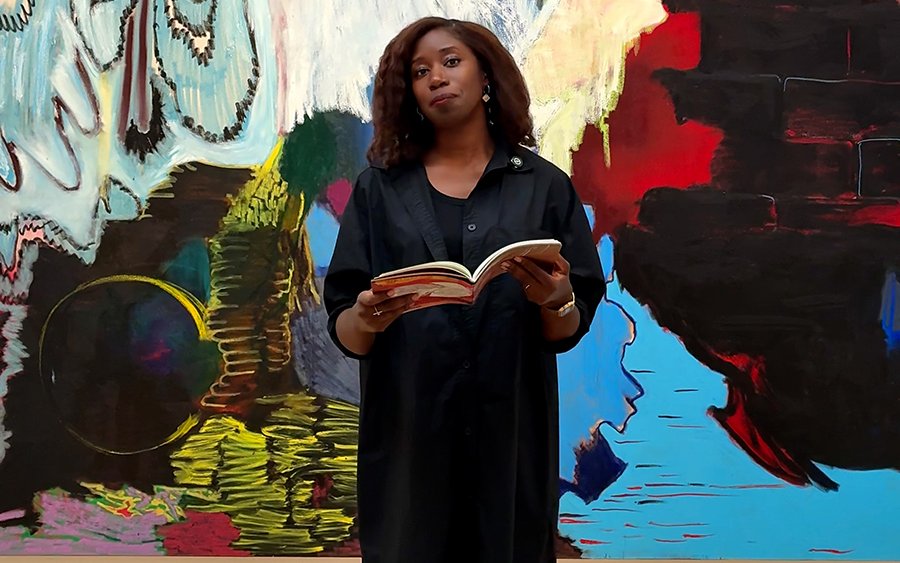What inspires Rachel Jones?
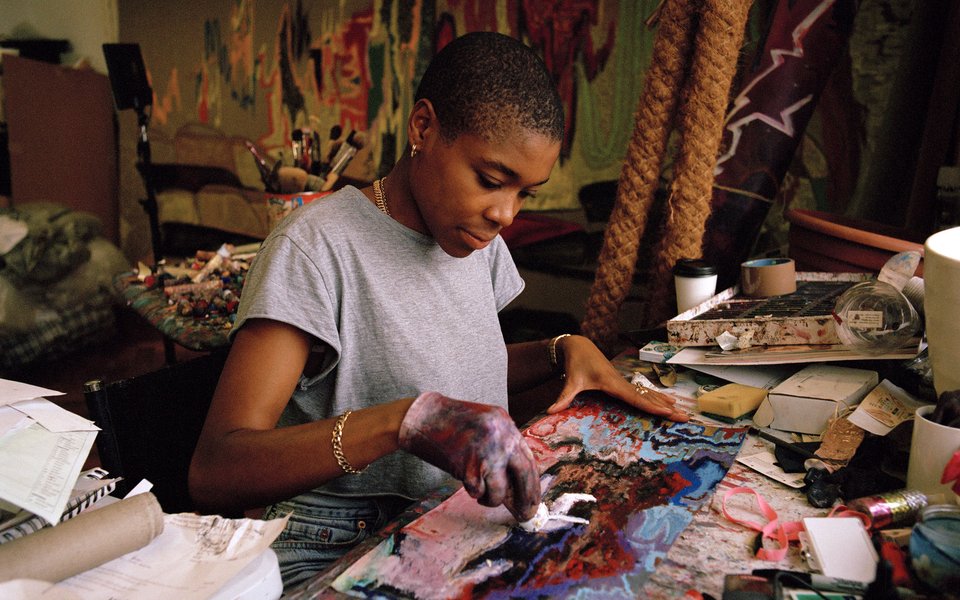
Curator Jane Findlay spoke with Rachel Jones about her artistic practice, use of recurring motifs, and how an historic painting from the Collection became the starting point for a new body of colour-rich works.
Renowned for her striking use of colour, blending of abstract and figurative motifs and distinctive approach to mark-making, Rachel Jones pushes the boundaries of contemporary painting. Gated Canyons, the artist's solo exhibition at Dulwich Picture Gallery, presents a new body of work made inJones's signature oil paints and oil sticks.
Jones was one of the youngest artists in the Hayward Gallery's 2021 show Mixing it Up: Painting Today, with her contribution singled out for praise in The Art Newspaper. She has exhibited at the Chisenhale Gallery and held her first US solo show at San Francisco's Museum of the African Diaspora (MoAD) in 2024. This year, Jones opened an exhibition at Regen Projects, Los Angeles, and will present an installation at London's Courtauld Gallery in autumn. In addition to her paintings, she has composed an operatic performance artwork, Hey Maudie, performed at St. James's Piccadilly in 2023, and designed the BRIT Awards 2024 trophy.
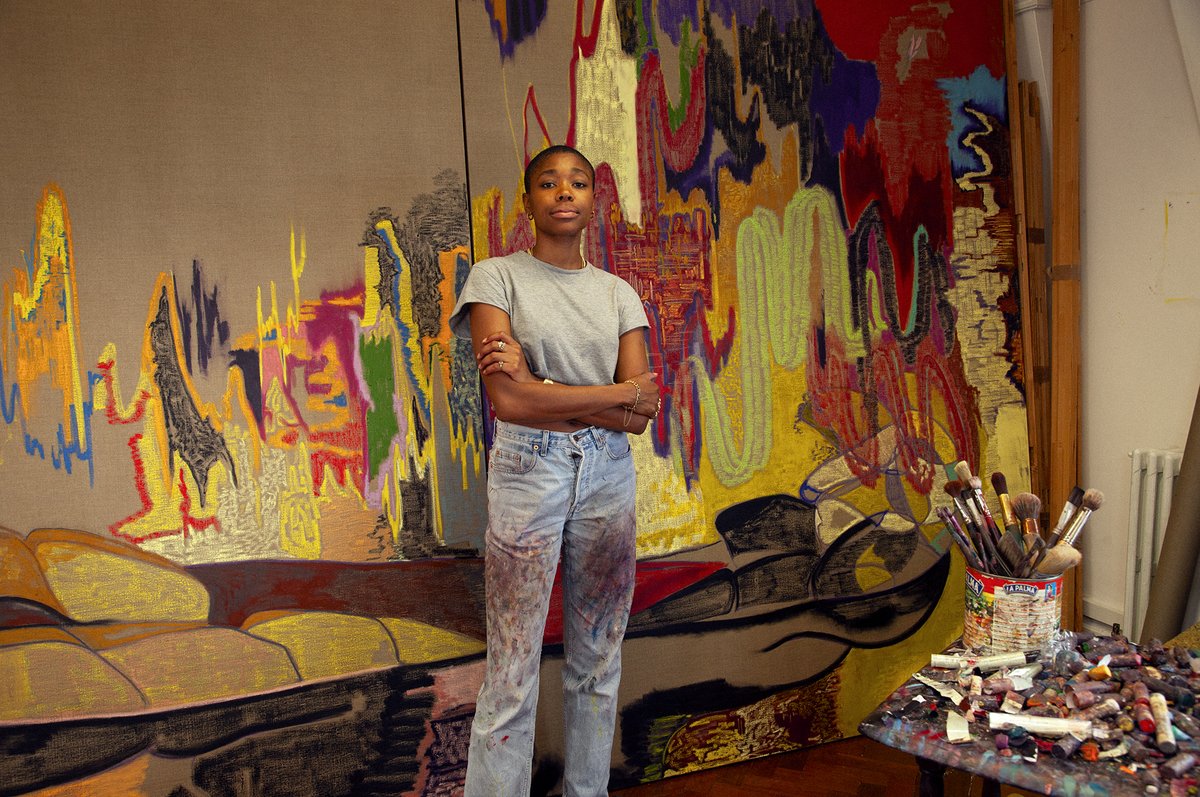
Conversations about a possible exhibition at Dulwich Picture Gallery first began nearly three years ago. As Jones recalls: " It was an intriguing opportunity to think about my relationship to painting and how the Gallery's historical works might relate to my practice. I was excited, but also a little nervous. I hadn't seen the Collection for a while, so I was going in with no idea of what to expect or what might resonate with me."
She was particularly drawn to Flemish artist Pieter Boel's Head of a Hound from about 1660: " It's quite a specific work at the Gallery, which hangs alongside grand portraiture and landscape painting. It was new for me to think about the difference in what's shown in a collection and what's given emphasis. The painting is also a study, so the idea that Dulwich wants to share the process of painting is interesting to me. It speaks to how I think about my own practice and the desire to show how a painting is made as part of how it's exhibited."
Gated Canyons is not simply about new paintings, but is a chance for Jones to introduce a new audience to the breadth of her work, with selected pieces from her previous series A Slow Teething, Say Cheeeeese, !!!!!, Red Shaped Mouths and Spliced Structures. This also means it is possible to survey the development of her painting, not only for the audience but also for the artist: "It's an amazing opportunity for me, both to reunite older works and because I've never seen paintings from different bodies of work together. It's important for me to look at my own practice and see the journey of my painting over the past seven years."
The exhibition at Dulwich will see some themes revisited and honed, while new elements and colours are brought into play: " There's still a strong thread that ties everything together in terms of the types of images, the materials and colour palette, while there are also shifts from each body of work." The mouth is a key, recurring image of Jones's work, signifying a portal, layered with cultural, emotional and historical meaning, that is central to her exploration of interiority, Blackness and self. Gated Canyons features the first manifestation of this mouth motif - in one of three works from Jones's Spliced Structures series from 2019, which will be shown to the public for the first time. As she says: "They're works that I've held onto because they're important to me. It's quite nerve -racking, actually, for them to be shown in the world."
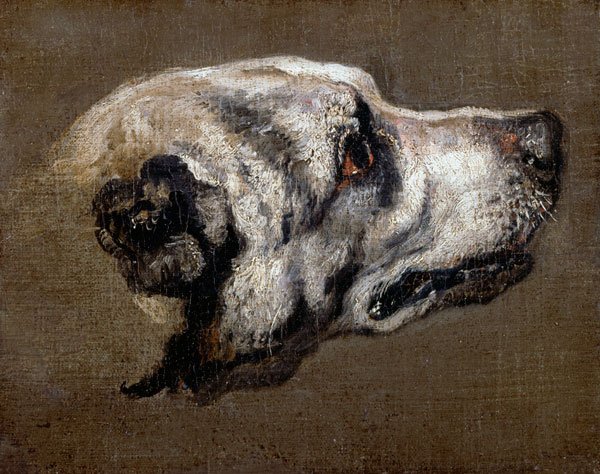
The bared teeth of Boel's hound gave Jones's motif a new point of departure, with the dog presenting an unpredictable element, its intentions or emotions unknown, simultaneously wild and domesticated. Jones has also varied the position and expression of her mouths on the canvas: "In the large works, they normally fill the painting and dominate the landscape. In these new works, though, that domination has a different level of intimacy. There are tongues, and the mouths are open and grinning." In part this change is due to the variation in scale of the works: " Previously, I would only give that sort of personality or agency to the mouths in smaller paintings. This is the first time the relationship I have with the smaller paintings and the pictorial language that exists there has started to feed into the larger works."
In addition to Boel's work, Jones deploys a range of other influences. Having first used cartoons as a source for her MoAD exhibition, she returns to them here, drawing on classic cartoons such as Looney Tunes, which she watched as a child. Jones explains: "With Head of a Hound as a reference, I was interested in the way that animals are described. In cartoons, they are often used to code behaviours or socialised norms. For instance, the idea of violence in animals is normal, but it's inappropriate with humans, so cartoons are a way of hiding or subverting complicated behaviours or psychological experiences. It's an interpretation of human behaviour via nonreal creatures, monsters or animals. That's intriguing to me."
In conjunction with the mouth motif is the newer symbol of bricks. This is expanding on something only touched on in her recent previous works: "I wanted to delve deeper into the idea of what they might symbolise. In the context of the paintings, they are another way to talk about socialised behaviours and this crossover between private and public spaces and interactions.'' They are used to create homes and places where people gather and feel protected. In her works sometimes bricks sit behind a mouth, or are in an abstract space or on the floor. As Jones says: " I've used them in different ways. They sit alongside the mouths in order to add more meaning around the idea of internal and external spaces, and how we describe or experience them. Bricks are charged with ideas around the psychology of a place geographically, but also the psychology of an individual and the tension of how those two things interact."
Jones has forged a distinct way of making art, encompassing both drawing and painting. Feeling alienated from painting as a student, she started to use drawing as a process of looking, eventually returning to painting through her use of oil sticks and oil pastels. Jones blends the materials with her fingers to apply rich and direct layers of colour on the surface.
Her relationship with colour and materials is broadened in Gated Canyons: "I definitely wanted to use a more unfamiliar colour palette with these paintings. I respond to yellow and red and blue in a strong way, and use those colours a lot, but I wanted to push that further." Acid tones, green, fluorescent green, pinks, purples and turquoise appear in these works, but "there are also more muted, richer tones that mean the paintings, in some ways, have quieter feelings in them, as opposed to all of the emotion being high octane".
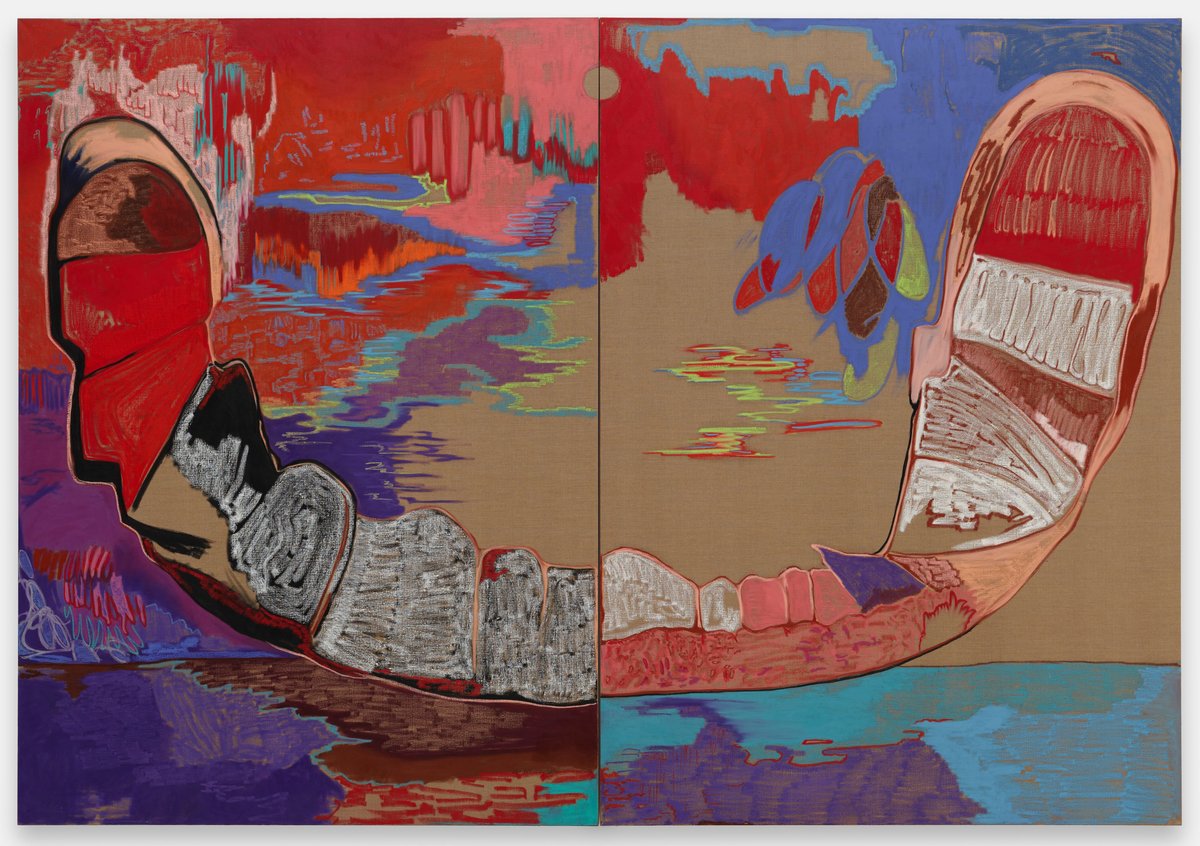
This richer, muted register of browns, peaches, black and white is augmented by leaving expanses of the linen on which she paints untouched, something first explored in her MoAD works: "The colours have to respond to the brown of the linen, because they aren't obliterating the surface, they need to negotiate the space with those large areas of untouched canvas. In a weird way having so much space left visible emphasises the areas that do have colour. Your eye goes towards them, because it wants to focus on parts of the painting where something is happening. But with that you then further notice the negative space where there is a moment for rest or reflection. In a way, the linen is reflecting colour to the painting. They mirror each other."
The title for Gated Canyons came late in the process. Confessing to not enjoying the process of titling works, Jones knew she wanted to reference the sense of space in the paintings: "I felt there was a combination of ideas around the physicality of space and place, but also a relationship to more personal, intimate places within ourselves, which are hidden from us and difficult to grapple with. A canyon is really unknowable in terms of its depth, so there are certain things that are wholly imagined, because we can never conceive how they're formed, how they exist, or what happens within them. It's quite terrifying, but also really majestic and beautiful."
Jones's work has been characterised as both abstract and figurative. She acknowledges that it has never been entirely one or the other: " I've been painting this way for about six or seven years, and you can always find a new way to describe something. The process of looking means that you're always understanding or interpreting things differently. It has always been part of my paintings for the teeth to describe something which is familiar, even if it's tenuous. I have always wanted there to be a sense of something known or something familiar in the way I paint or describe an object."
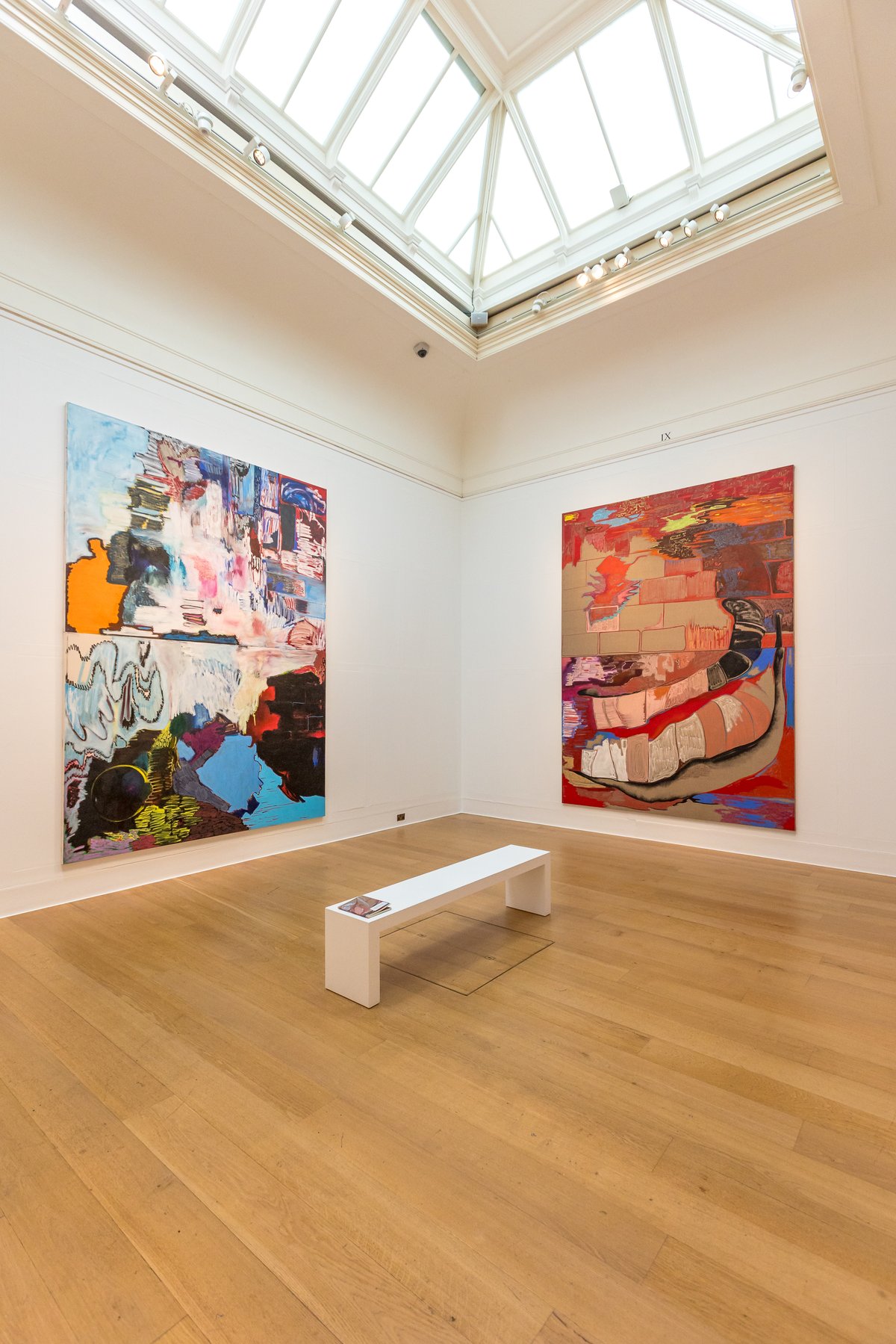
Presenting work at the historic Gallery, she observes that the pieces she has created for this show are not just a response to the Collection, but an opportunity to move her work forward. "Something more unconscious came out in the process of making these paintings. It's really helped me think about my own relationship to the images that I use to inspire my work. When I saw Head of a Hound, I wanted to make paintings that had that tension, nuance and ambiguity, but also a generosity to connect to the work and relate to it. I thought, 'I'd love to make paintings that have t hat same presence and impact,' so I'm glad that these works, for me, sit within that same emotional space as Head of a Hound."
Rachel Jones: Gated Canyons runs until 19 October 2025.
Jane Findlay is Head of Programme and Engagement at the Gallery. This article initially appeared in our InView magazine 2025.

